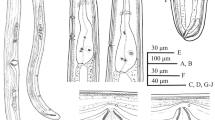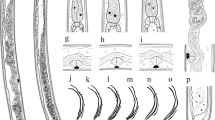Abstract
Several species of trichodorid nematodes cause economically important disease on plants. Trichodorus comprises most of the trichodorid species. Trichodorus golestanensis n. sp. is described from a forest park in northern Iran. The new species belongs to the T. lusitanicus morpho-species group and is characterized in male by three ventromedian cervical papillae of which two at level of onchiostyle region, three ventromedian precloacal supplements, the posterior one just anterior to retracted spicules and ventrally curved spicules with mid-blade indentation provided with a few bristles. Females are distinguished by well developed triangular vaginal sclerotized pieces in lateral optical view, a rhomboid-shaped vagina and a transverse slit-like vulva in ventral view. Molecular analysis using the sequence of D2-D3 expansion segment of 28S rDNA differentiated the new species and confirmed the relationships of T. golestanensis n. sp. with T. andalusicus and T. asturanus. The sequences of D2-D3 regions were also provided for previous trichodorid records from Iran T. gilanensis, P. teres and N. minor together with discussion of their relationship.




Similar content being viewed by others
References
Decraemer, W., & Baujard, P. (1998). A polytomous key for the identification of species of the family Trichodoridae Thorne, 1935 (Nematoda: Triplonchida). Fundamental and Applied Nematology, 21, 37–62.
De Grisse, A. (1969). Redescription ou modification de quelques techniques dans l’étude des nématodes phytoparasitaires. Meded Faculteit Landbouwwetenschappen Rijksuniversiteit Gent, 34, 351–369.
De Waele, D., & Hashim, Z. (1983). Trichodorus orientalis n. sp. (Nematoda: Trichodoridae) from Jordan and Iran. Systematic Parasitology, 6, 63–67.
De Waele, D., & Sturhan, D. (1987). Trichodorus persicus n. sp. (Nematoda: Trichodoridae) from Iran. Systematic Parasitology, 10, 79–83.
Duarte, I. M., Almeida, M. T. M., Duarte, M. M., Brown, D. J. F., & Neilson, R. (2010). Molecular diagnosis of trichodorid species from Portugal. Plant Pathology, 60(3), 586–594.
Hall, T. A. (1999). BioEdit: CAB. a user-friendly biological sequence alignment editor and analysis program for Windows 95/98/NT. Nucleic Acids Symposium Series, 41, 95–98.
Heydari, R., Tanha Maafi, Z., Omati, F., & Decraemer, W. (2014). First report of Paratrichodorus teres (Diphtherophorina, Trichodoridae) from Iran. Australasian Plant Disease Notes. doi:10.1007/s13314-014-0131-4.
Jenkins, W. R. (1964). A rapid centrifugal-flotation technique for separating nematodes from soil. Plant Disease Report, 48, 692.
Kumari, S., & Subbotin, S. A. (2012). Molecular characterization and diagnostics of stubby root and virus vector nematodes of the family Trichodoridae (Nematoda: Triplonchida) using ribosomal RNA genes. Plant Pathology, 61, 1021–1031.
Larkin, M. A., Blackshields, G., Brown, N. P., Chenna, R., Mcgettigan, P. A., Mcwilliam, H., et al. (2007). Clustal W and Clustal X version 2.0. Bioinformatics, 23, 2947–2948.
Maafi, T. Z., & Decraemer, W. (2002). Description of Trichodorus gilanensis n. sp. from a forest park in Iran and observation on Paratrichodorus tunisiensis (Siddiqi, 1963) Siddiqi, 1974 (Nematoda: Diphtherophorina). Nematology, 4, 43–54.
Posada, D. (2008). JModeltest: phylogenetic model averaging. Molecular Biology and Evolution, 25, 1253–1256.
Pourjam, E., Asghari, R., Ramaji, F. A., & Heydari, R. (2011). Some species of plant parasitic nematodes from Iran. Iranian Journal of Plant Pathology, 47(4), 141–143.
Subbotin, S. A., Sturhan, D., Chizhov, V. N., Vovlas, N., & Baldwin, J. G. (2006). Phylogenetic analysis of Tylenchida Thorne, 1949 as inferred from D2 and D3 expansion fragments of the 28S rRNA gene sequences. Nematology, 8, 455–474.
Swofford, D. L. (2003). PAUP* (Phylogenetic Analysis Using Parsimony (PAUP*and Other Methods), Version 4). Sunderland: Sinauer Associates.
Williams, B. D., Schrank, B., Huynh, C., Shownkeen, R., & Waterston, R. H. (1992). A genetic mapping system in Caenorhabditis elegans based on polymorphic sequence tagged sites. Genetics, 131, 609–624.
Zahedi, E., Niknam, G., Decraemer, W., & Karegar, A. (2009). Trichodorus arasbaranensis n. sp. (Nematoda: Trichodoridae) from a natural forest in Arasbaran, north-west Iran. Nematology, 11, 243–252.
Acknowledgments
We would like to thank Dr. J. Abdollahzadeh, Department of Plant Protection, University of Kurdistan, Iran for valuable help in analysing molecular data.
Author information
Authors and Affiliations
Corresponding author
Rights and permissions
About this article
Cite this article
Heydari, R., Tanha Maafi, Z. & Decraemer, W. Morphological and molecular characterisation of Trichodorus golestanensis (Nematoda: Trichodoridae), a new species from Iran. Eur J Plant Pathol 140, 329–340 (2014). https://doi.org/10.1007/s10658-014-0466-x
Accepted:
Published:
Issue Date:
DOI: https://doi.org/10.1007/s10658-014-0466-x




